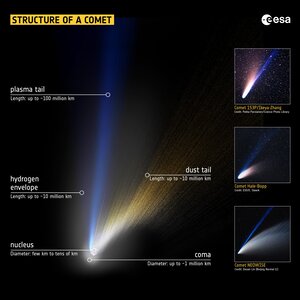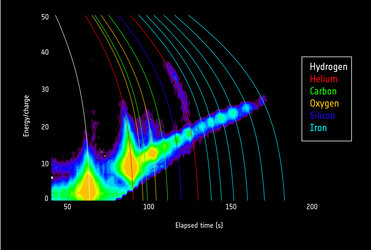

Tasting a comet’s tail
This plot series represents data collected by the Solar Wind Analyser’s Heavy Ion Sensor as the ESA/NASA Solar Orbiter spacecraft passed through Comet Leonard’s tail in December 2021. The data cover 11-20 December, with the first and last plot before and after the tail crossing, respectively, marked by an absence of singly charged ions. During the tail crossing the instrument detected particles that are attributable to the comet rather than the solar wind, for example ions of oxygen, carbon and molecular nitrogen, and molecules of carbon monoxide, carbon dioxide and water. (Ions are atoms or molecules that have been stripped of one or more electron and now carry an electrical charge.)
The plot illustrates the accumulation of ‘hits’ of different cometary and solar particles over the course of each day, and records the time it takes for individual particles to travel through the core of the instrument (time of flight), along with its energy/charge. In general, heavier particles take longer to travel than lighter ones.
Particles of different mass/charge distribute along specific lines in the plot. The regular solar wind particles cluster along one line (labelled Vsw) in high numbers (indicated by the red and green colours). Boundary lines are also marked for particles travelling twice as fast as solar wind particles (2Vsw) and 0.8 times as fast (0.8Vsw). The density of green colours in distinct bands in the right hand side of the plot reveals particles that have different charge characteristics to those expected in the solar wind, and, in addition, molecules simply not found in the solar wind.
Data like this collected over many days helps profile the comet’s ion tail. The data are used to determine the rate at which the solar wind is stripping material from the comet, for example by comparing the abundances of ‘parent’ molecules (e.g. carbon monoxide, CO), with the individual atomic components (in that case, carbon and oxygen). Combined with magnetic field data, scientists will also be able to explore local space plasma instabilities generated by the interaction of the newly created ions with the solar wind itself.





